If you’re thinking about installing a ceiling fan in your kitchen, there are a few things to bear in mind first. In this article, we will answer some of the most common questions. We will also provide some useful tips on how to choose and install a fan in your kitchen.
Reasons To Put A Ceiling Fan In Your Kitchen
Putting a ceiling fan in your kitchen can be beneficial for several reasons. Ceiling fans provide air circulation to help reduce the buildup of heat, moisture, and cooking odors. They also add style and personality to your kitchen space, as well as increase its energy efficiency.
It’s important to consider the size and layout of your kitchen. Ceiling fans work best in larger kitchens because they need to cover a greater area for air circulation. If you have a small kitchen then a ceiling fan may not be the best option. [1]
Another thing to consider is whether or not you can install the fan yourself. Installing a ceiling fan requires quite a bit of electrical work so if you don’t feel comfortable doing it yourself, it’s best to hire an electrician for the job.
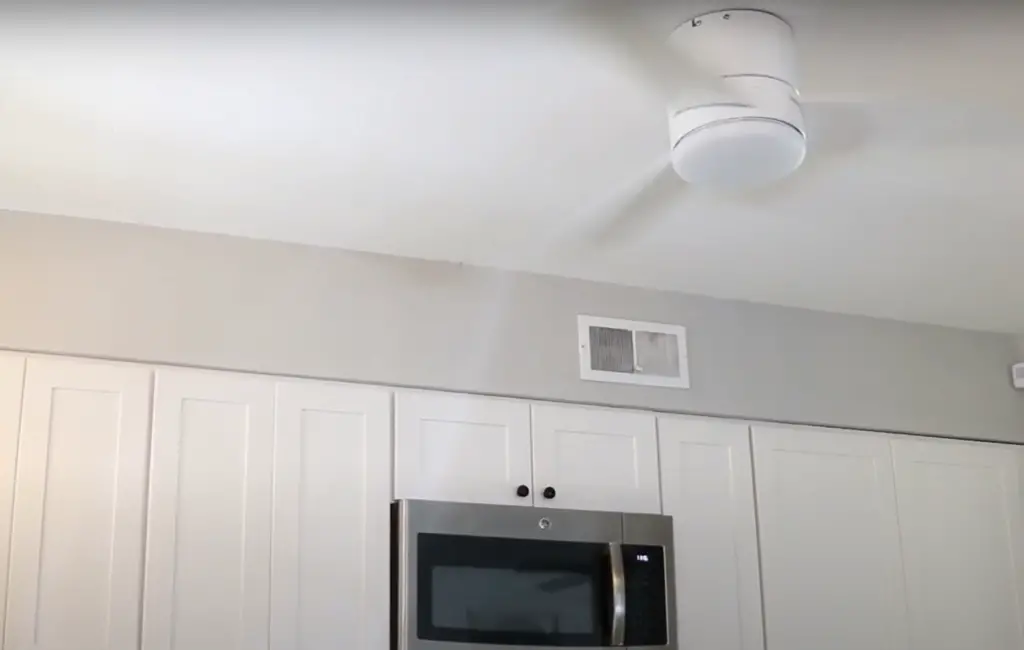
Finally, make sure that your chosen ceiling fan is UL-listed for wet locations such as kitchens (some fans are only suitable for dry locations). This will ensure that your fan is safe to use in a kitchen setting.
Benefits Of A Ceiling Fan In The Kitchen
Now let’s take a look at some of the benefits.
Finally, ceiling fans can add a stylish touch to your kitchen.
Keeps You Cool
One of the primary reasons why you should install a ceiling fan in the kitchen is because it will help keep you cool. While an A/C unit will do a great job of cooling down the room, running the air conditioner constantly can be expensive. A ceiling fan, on the other hand, is much more affordable and can provide just enough circulation to make things comfortable without breaking the bank.
In addition to keeping you cool, a ceiling fan helps reduce humidity levels in your kitchen. High humidity levels can lead to mold growth or cause food to spoil faster. By circulating air around the room, a fan helps keep moisture from settling and creating a humid environment.
Lowers Home Energy Costs
Another great reason is that it can help lower your home energy costs. As mentioned above, circulating air around the room will reduce the amount of energy needed for cooling. But fans also have other energy-saving benefits.
Ceiling fans work by pushing warm air down from the ceiling and pulling cooler air up from the floor. This helps even out the temperature in the room, resulting in fewer hot and cold spots. And because less energy is being used to cool each spot, your overall home energy costs will be reduced as well.
Helps Rid Of Odors And Smoke
One more benefit is helping rid of odors and smoke. Ceiling fans are designed to circulate air around rooms, which helps disperse cooking fumes and other odors more quickly. This will keep your kitchen smelling fresh and clean no matter how often you cook.
Smoke can be particularly difficult to get rid of in small kitchens, so having a ceiling fan will ensure that smoke doesn’t linger for too long. By pushing the smoke up towards the ceiling, the fan will help clear things out faster than if you were relying on convection alone.
Provides An Additional Lighting Fixture/Source
Another great benefit is providing an additional lighting fixture/source. Most ceiling fans come with light fixtures, so you can use them to provide additional illumination for your kitchen. This can be especially useful if you’re looking to save on energy costs and don’t want to rely solely on overhead lighting.

Ceiling fans also make great task lighting sources. The light from the fan will allow you to see what you’re doing more clearly while cooking or baking, making it easier to avoid mistakes. So if you need another source of illumination in your kitchen, then a ceiling fan should definitely be considered.
Installing a ceiling fan in the kitchen can be a great way to improve air circulation, reduce energy costs, and provide an additional lighting source. Plus, some fans come with decorative blades, light fixtures, or color options that can help liven up the space and make it more inviting. So if you’re looking for a way to cool down your kitchen while also adding some style and personality, then installing a ceiling fan is definitely worth considering!
Helps Keep Mosquitos And Other Insects Away
The last benefit of installing a ceiling fan in your kitchen is that it can help keep mosquitos and other insects away. Mosquitos are attracted to heat and humidity, so having a fan to circulate air around the room will make it less appealing for them.
In addition, ceiling fans create a breeze that can also help deter other flying bugs such as bees or wasps. So if you’re looking for an effective way to keep your kitchen free from pests, then installing a ceiling fan should definitely be considered. [2]
Installing a ceiling fan in your kitchen is not only beneficial for cooling down the space but also for helping improve air circulation, reduce energy costs, provide additional lighting sources and keep mosquitos and other insects away. So if you’re looking for a way to make your kitchen more comfortable and inviting, then installing a ceiling fan is definitely worth considering!
Types of Kitchen Ceiling Fans
When considering ceiling fans for your kitchen, you’ll have a few options to choose from. You can go with a basic ceiling fan with no lights, or opt for one with integrated lighting. For example, some fans come with multiple light fixtures that hang down from the motor housing. These are great for adding ambiance and lighting up task areas in the kitchen like counters and islands.
The other type of fan is known as an “island fan” which is designed specifically for kitchens with islands or high ceilings. These fans are much larger than traditional ceiling fans and feature multiple motors that spin blades at different speeds to create more airflow in large spaces. They also come with their own specialized lighting system so you don’t have to worry about buying additional lighting fixtures.
Long Blades vs. Short Blades
Another important factor to consider when choosing a kitchen ceiling fan is blade length. Longer blades typically cover more area and move more air, making them a better option for large kitchens with multiple occupancies. On the other hand, short blades are better suited to smaller kitchens that don’t need as much airflow.
You should also be aware of the type of blade material you choose as this will affect how well it moves air around your kitchen. Wood or plastic blades are better at moving air than metal or aluminum blades, so keep that in mind when making your selection.
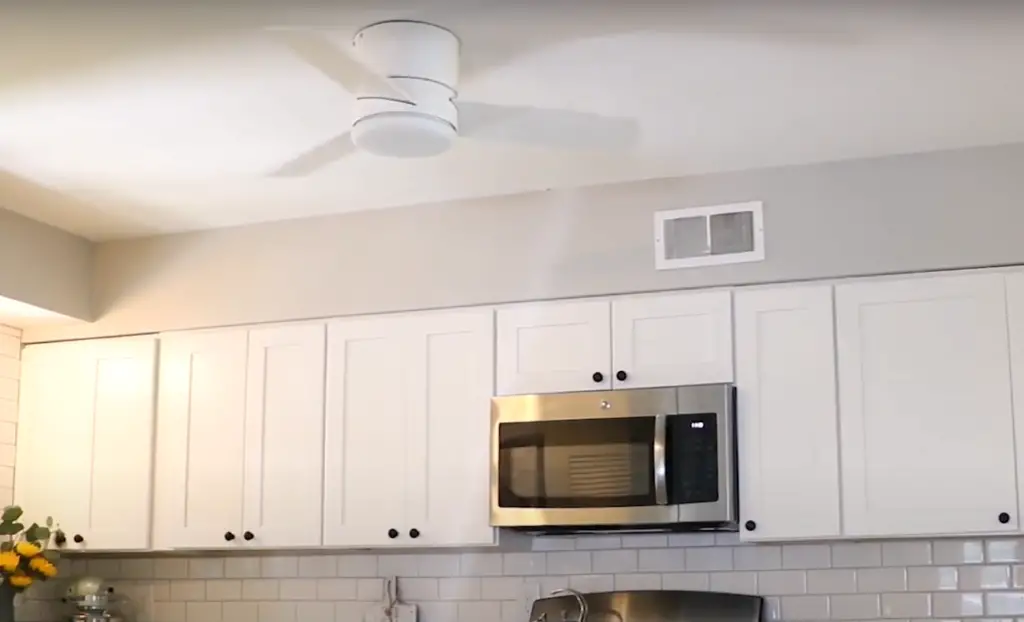
Three or Five Blades?
The number of blades on a ceiling fan is another important factor to consider. Fans with three or five blades generally provide the best air circulation, though you may also find some fans with four-blade configurations. The more blades a fan has, the more air it will move around your kitchen. However, keep in mind that more blades typically also means longer motor and blade arm assembly, so you’ll need to make sure there is enough space for it in your kitchen.
Light vs. No Light
You’ll need to decide if you want a fan with or without light fixtures. Fans with lights can provide extra illumination and create an inviting atmosphere in your kitchen, while fans without lights can be used to circulate air more efficiently. If you choose to go with a fan that has lighting fixtures, make sure they are UL-Listed and rated for damp locations so they won’t be damaged by steam or condensation from cooking.
Remote vs. No Remote
One more factor to consider when choosing a kitchen ceiling fan is whether or not you want it to have a remote control. Remote-controlled fans provide added convenience and allow you to operate the fan from anywhere in your kitchen. They are also great for controlling multiple fans at once, which can be especially helpful if you have multiple occupancies in your kitchen.

AC vs. DC Motors
Finally, you’ll want to consider the type of motor your fan has. AC motors are the most common and used in most ceiling fans, while DC motors tend to be more efficient and quieter. DC motors also typically come with built-in speed controls that allow you to regulate the fan’s output for better air circulation in different parts of your kitchen.
Things To Consider While Installing A Kitchen Ceiling Fan
There are a few things to consider while installing a kitchen ceiling fan. Firstly, it’s important to make sure your ceilings are the correct height in order for the fan blades to be able to move freely without hitting the wall or other obstacles. Additionally, you’ll want to make sure there’s enough room between the fan and any cabinetry above it so that air can circulate effectively. It’s also important to double-check your electrical panel in order to ensure that it can safely handle a ceiling fan installation, as well as any extra lighting you may want to be included with the fan. Finally, if you’re going with a remote control system, then you will need to make sure all wires are properly connected and working correctly before turning on the fan. In general, ceiling fans should be installed by an experienced and certified electrician to ensure it’s done correctly.
As with most home projects, safety should always come first. Be sure to wear proper safety gear such as goggles, gloves, and long sleeves while working near electricity, and switch off all electrical power before beginning work on any electrical appliances or wiring. Moreover, make sure you follow all instructions carefully in order to avoid any potential hazards. With some planning and care, installing a kitchen ceiling fan can quickly become a breeze!
Placement
When it comes to the placement of kitchen ceiling fans, there are a couple of common areas that are most suitable. In general, you’ll want to install the fan in an area where it can create good airflow throughout the room and provide maximum efficiency. Specifically, this could be above or near a large island, dining table, stovetop, or sink. Placing the fan too close to cabinets may limit its ability to move air around properly so make sure you measure the distance before installation.
Once your fan is installed in the right place, you can adjust its height by either shortening or lengthening its chain depending on your preferences. If you’re using a remote control system then you’ll have additional flexibility when it comes to controlling the fan’s speed and direction.
Style
When selecting a style and design, you’ll want to consider both form and function. Do you prefer a traditional or modern look? Also, what type of fan do you need – one with multiple speeds, adjustable lights or a remote control system?
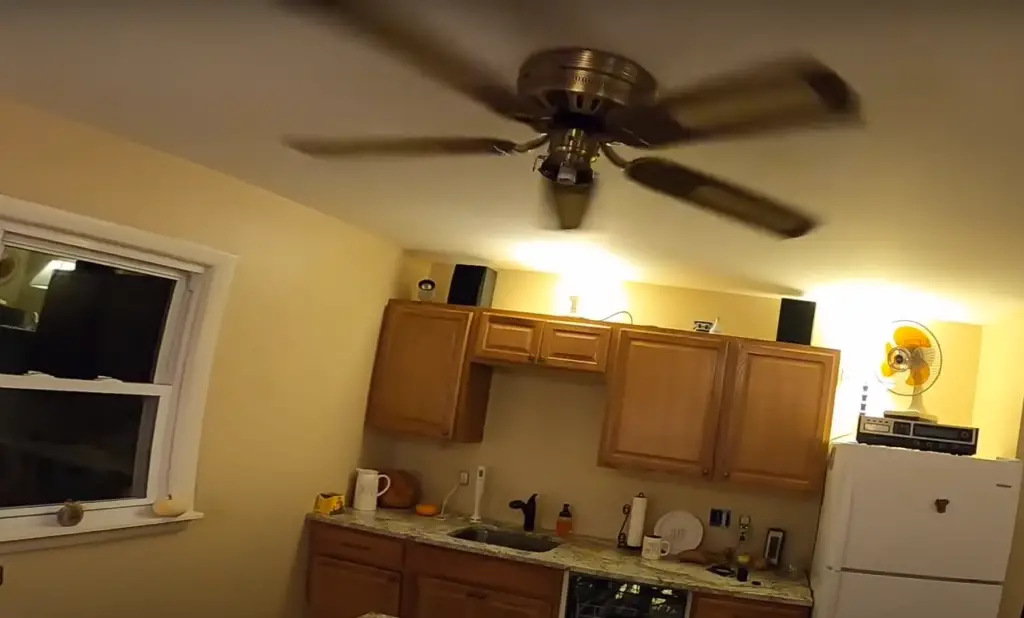
Keep in mind that in addition to aesthetics, the size of the fan is also important when it comes to making sure it provides enough airflow to cool down your kitchen. Generally speaking, bigger fans are better for larger kitchen areas while smaller ones may be more suitable for tighter spaces.
Controls
When it comes to controls, ensure your fan is equipped with the right features. This could include a remote control system or manual switches that will allow you to easily adjust the speed and direction of the fan from any distance. Additionally, some fans come with built-in lights that you can use for additional illumination in your kitchen.
Once you’ve chosen the perfect fan for your kitchen, all that’s left is installation! With careful planning and attention to detail, installing a ceiling fan in the kitchen should be relatively straightforward. Remember – safety always comes first! And with these tips in mind, you’re now ready to enjoy an efficient and cool breeze in your kitchen all summer long. Enjoy!
Check for airflow ratings
Before you decide to install a ceiling fan in your kitchen, one of the most important considerations is how well it will work. To determine this, you need to check the airflow ratings of the fan. Airflow rating measures the cubic feet per minute (CFM) that the fan can move around. Generally speaking, larger rooms require more CFM because they need to be cooled or heated faster than smaller rooms. The size of your kitchen and its layout will factor into determining what type of fan would be best for your home.
Another thing to consider when assessing airflow ratings is whether or not your ceiling is high enough for a fan of sufficient power. If it’s too low, then you may need to opt for a smaller model that won’t be able to move as much air.
Finally, make sure to evaluate the noise level of the fan you’re considering for your kitchen. You don’t want it to be too loud and disrupt conversations or peace and quiet in other parts of your home.
Ensure the fan is the right size for your kitchen
It’s important to make sure you buy a fan that’s the right size for your kitchen. The fan needs to be big enough to circulate air adequately, but not so big that it takes up too much space. Measure the length and width of your kitchen before you purchase a ceiling fan, and take into account any bulkheads or other obstructions that may limit the amount of available headroom.
Look for energy star rated fans
One of the essential things to consider when deciding whether you can put a ceiling fan in the kitchen is to look for energy-star-rated fans. Energy Star products are designed to save energy, reduce air pollution and lower your monthly bills. These fans are more efficient than conventional models, which helps reduce both energy consumption and heat buildup in the room. Additionally, they may also be eligible for rebates from your local utility company or state tax credits.
How accessible is the location your fan will be
When you’re choosing the perfect spot for your ceiling fan, make sure it’s within easy reach. You don’t want to have to climb up and down a ladder every time you need to change settings on the fan or clean it! If your kitchen has a higher ceiling, then you will probably need an extension rod so that the fan can hang lower and be accessed more easily. Most fans come with a standard length of four inches, but there are rods available in various lengths up to twelve inches to give you better access and reachability.
Finally, consider if there are any obstructions near the intended installation site that could reduce airflow while using your ceiling fan. You want as much airflow as possible so make sure there’s nothing blocking the area directly around the fan such as cabinets, furniture or other items.
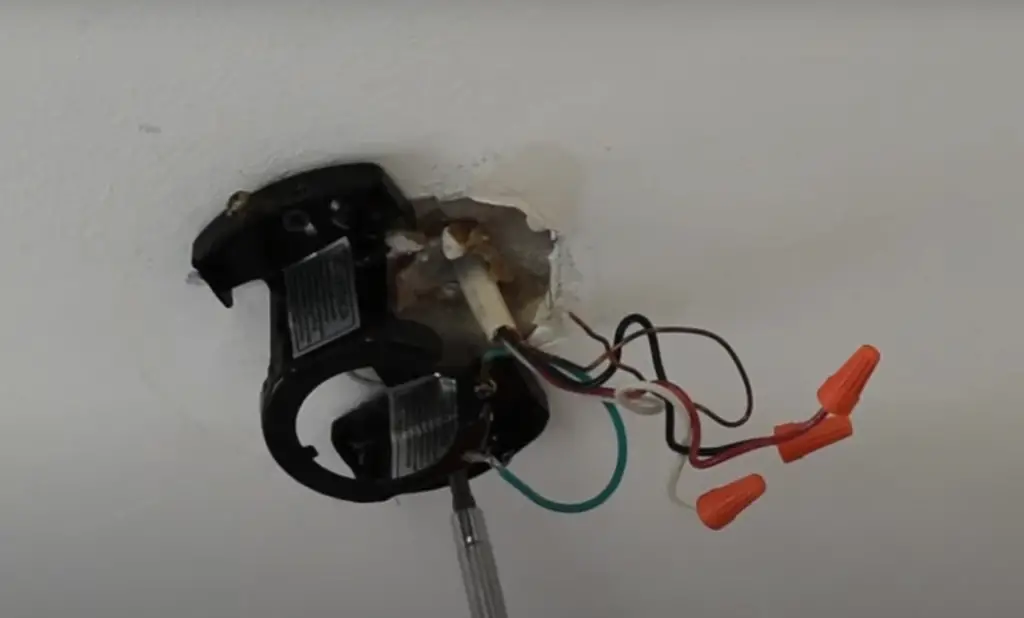
A well-designed kitchen with an accessible ceiling fan can help provide efficient air circulation throughout your entire home! With these tips in hand, you can be sure you’re choosing the best spot for your ceiling fan and maximizing its efficiency.
Installing a Ceiling Fan in the Kitchen: Considerations and Benefits
Adding a ceiling fan to your kitchen can improve ventilation and comfort. Here’s a comparison of considerations and benefits when installing a ceiling fan in the kitchen.
| Consideration/Benefit | Explanation |
|---|---|
| Improved Ventilation | Installing a ceiling fan can enhance air circulation and reduce cooking odors, making the kitchen more comfortable. |
| Energy Efficiency | Ceiling fans are generally energy-efficient and can help distribute conditioned air, potentially reducing cooling costs. |
| Lighting Options | Many ceiling fans come with integrated lighting, providing both illumination and air movement in the kitchen. |
| Year-Round Use | Ceiling fans often have a reverse setting, which can be used in the winter to distribute warm air evenly. |
| Style and Décor | Ceiling fans come in various styles and finishes, allowing you to choose one that complements your kitchen’s aesthetic. |
| Installation Height | Consider the ceiling height in your kitchen to ensure safe installation and optimal performance of the fan. |
Explanation of the table:
This table provides a comparison of considerations and benefits when installing a ceiling fan in the kitchen. Ceiling fans can enhance ventilation, offer energy efficiency, provide lighting, and be used year-round. Additionally, they come in various styles to match your kitchen’s décor. However, it’s important to consider ceiling height for safe and effective installation.
FAQ
Which fan is best for the kitchen?
When shopping for a ceiling fan for your kitchen, there are several things to consider. The size of the fan is important as too small or large of a fan can be a hazard in such an enclosed space. You should also pay attention to the airflow rating, which will determine how much air circulation you get from the fan and how much noise it makes while running. Finally, look at the blades and light fixtures included with the fan. Many fans come with options like remote-controlled lights and reversible blades that can help cool down your kitchen even more on hot summer days. Most importantly, make sure to choose a model that is rated safe for use in kitchens – these usually have features such as moisture-resistant materials and sealed motors to prevent fires and other hazards.
Additionally, consider the location of the fan. A good rule of thumb is to install it at least 7 feet off the floor and 18 inches away from any walls or cabinets. This will ensure maximum air circulation and reduce noise levels while running. Finally, pay close attention to the weight capacity of a ceiling fan when installing – heavier models require additional support which may include wall braces and extra mounting hardware.
Can you put a ceiling fan anywhere?
Yes, you can put a ceiling fan anywhere that has an electrical outlet. That being said, there are certain places where it is not recommended to install a ceiling fan. For example, in bathrooms or laundry rooms where moisture is present and could cause the fan motor to corrode or short out. It’s also important to make sure that there is enough clearance around the fan blades so as not to obstruct airflow in any way. [4]
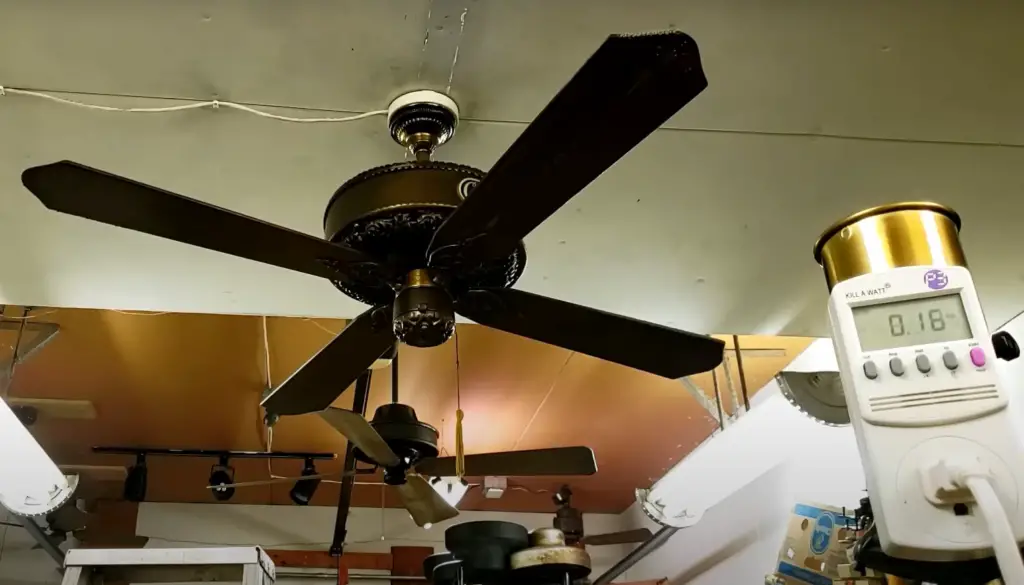
Do you need a fan in the kitchen?
When you think of a ceiling fan, you usually think of a bedroom or living room. But the kitchen is often overlooked when it comes to fans. Generally speaking, it’s not necessary to have a fan in the kitchen because there isn’t usually enough heat coming from cooking and appliances to warrant one. However, that doesn’t mean it can’t be beneficial — depending on the size and layout of your kitchen, having a fan can help keep the air circulating and clean out any lingering cooking smells more quickly.
Plus, depending on where you place your oven or stovetop, putting a ceiling fan in the kitchen could help prevent smoke from entering other parts of your home. If you do decide to add one, be sure it has a light fixture attached so that you can use it as both a fan and additional lighting. To make up for the lack of air conditioning in most kitchens, install an exhaust fan near your cooktop or oven to help remove smoke and steam.
What size ceiling fan do I need for my kitchen?
This is a common question for homeowners looking to add a ceiling fan in their kitchen. The size of the fan will depend on the size of your room, as well as the design of your kitchen. Generally, a kitchen ceiling fan should be at least 36” in diameter, with larger rooms needing a larger size. Additionally, make sure you check the weight capacity of any fan you purchase to ensure it’s able to hold up whatever lights and other fixtures you plan on adding. Then measure the distance from the floor to the ceiling and subtract 10 inches for safety reasons to determine how long down rod is needed. This will help keep your fan out of reach but still within range of providing adequate air circulation. [5]
Another important factor when choosing the right size fan for your kitchen is its height. Ceiling fans should be installed at least seven to eight feet off the ground, so make sure you measure your ceiling before purchasing a fan. This distance allows for maximum air circulation and helps prevent any potential safety hazards.
Finally, consider choosing an Energy Star-rated ceiling fan for improved efficiency. An energy-efficient fan may cost extra upfront but can save money on electricity costs in the long run.
Also, keep in mind that it’s best to hire a professional electrician.
Can a ceiling fan effectively cool a kitchen space?
Ceiling fans are generally effective at providing air circulation and can help with cooling a kitchen space by promoting airflow and distributing air more evenly. However, their cooling efficiency may vary depending on factors such as the kitchen’s size and layout.
What are the benefits of having a ceiling fan in the kitchen?
Having a ceiling fan in the kitchen can offer several benefits, including improved air circulation, enhanced comfort by reducing hot spots, and potential energy savings by allowing you to raise the thermostat temperature while maintaining a comfortable atmosphere.
Are there any safety precautions to follow when using a ceiling fan in the kitchen?
When using a ceiling fan in the kitchen, it’s essential to ensure that it’s installed at a safe height, away from any flammable materials, and free from obstructions. Additionally, regular maintenance, such as cleaning the fan blades and checking for loose parts, is crucial to prevent safety hazards.
What type of ceiling fan is suitable for kitchen use?
For kitchen use, it’s recommended to select a ceiling fan designed for damp or wet locations. These fans are built to withstand moisture and humidity, making them more suitable for the kitchen environment where cooking can generate steam and moisture.
Can I install a ceiling fan in a kitchen with a low ceiling?
You can install a ceiling fan in a kitchen with a low ceiling, but you should choose a flush-mount or low-profile fan specifically designed for low ceilings. These fans are installed closer to the ceiling to provide ample airflow without compromising headroom.
Useful Video: Best Kitchen Ceiling Fans with Light
Conclusion
When it comes to installing a ceiling fan in your kitchen, there are a few things to consider. Ensure you choose a fan that is the right size for the room, and one that will be able to provide enough airflow. Also, make sure that it is properly installed so that everyone in your home can stay safe while using it. With the right precautions and research, you can have a beautiful and functional ceiling fan in your kitchen.
No matter what type of fan you decide on, having one in the heart of your home makes a great statement piece and provides much-needed air circulation throughout the space. So if you’re looking for an easy way to give your kitchen some style, why not give ceiling fans a try?
This article was written with the intention of providing helpful information and tips on how to go about installing one safely and efficiently. We hope you’ve found this article useful. Thanks for reading!
References:
- https://hvacseer.com/put-ceiling-fan-in-kitchen/
- https://rethority.com/ceiling-fan-in-kitchen/
- https://www.polarelectric.in/blog/is-it-a-clever-idea-to-install-a-ceiling-fan-in-our-kitchen/
- https://www.croppmetcalfe.com/blog/inside_your_home/can_you_install_a_ceiling_fan_in_any_room/
- https://www.thisoldhouse.com/fans/21018783/how-to-size-up-a-ceiling-fan





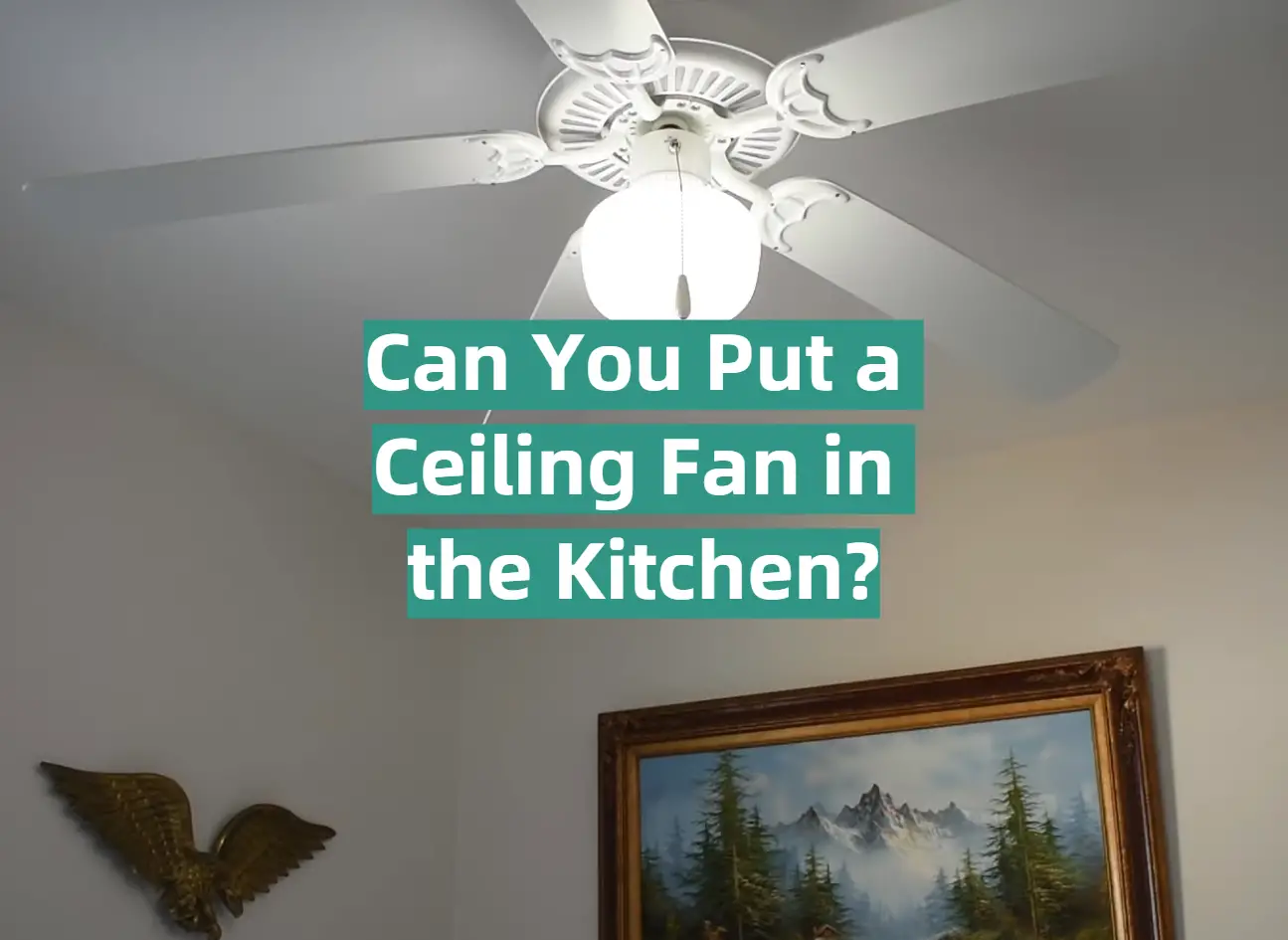








Leave a Reply